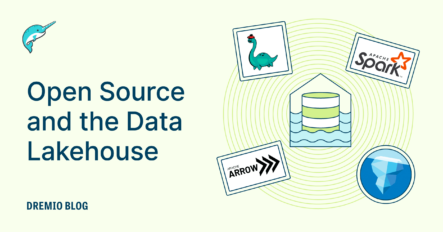8 minute read · February 1, 2024
Open Source and the Data Lakehouse: Apache Arrow, Apache Iceberg, Nessie and Dremio

· Senior Tech Evangelist, Dremio

The "open lakehouse" concept is gaining prominence as the apex of the evolution of data lakehouse architecture. This approach leverages open source components to create a robust data management ecosystem in terms of tool interoperability, performance, and resilience by design. This article aims to delve into the critical open source components that form the backbone of open lakehouse architecture and examine how they drive a better data platform. We will also explore how Dremio, the data lakehouse platform, integrates these components to provide a seamless and efficient data management experience.

The Significance of Open Source in Data Lakehouses
The rise of open source software has been a driving force in the technology sector, and its impact on data architecture is no exception. Open source is pivotal to modern data architecture because it fosters innovation, flexibility, and community-driven progress. In the realm of data lakehouses, open source components provide a foundation upon which robust, scalable, and adaptable data architectures can be built.
Apache Arrow: The Foundation for High-Performance Analytics

Apache Arrow is at the heart of many high-performance analytics systems and is a component of open lakehouse architecture. Apache Arrow is an in-memory columnar data format optimized for high-speed, efficient data processing and analysis. Its design enables rapid data movement and interoperability between various systems and languages, making it an ideal standard for representing data in memory and transferring data across different systems. Apache Arrow is a cornerstone for analytics platforms requiring high-speed data processing and analysis capabilities by facilitating quicker data access and reducing overhead. Dremio uses Apache Arrow for processing data and supports Apache Arrow Flight to transport large data volumes at high speeds.
Apache Iceberg: Transforming Data Lake Storage

Apache Iceberg plays a transformative role in the open lakehouse architecture. It acts as an open standard for creating a metadata layer that allows data lake storage to be viewed and managed as a coherent database of tables. Apache Iceberg brings several advanced features to data lake management, such as ACID (atomicity, consistency, isolation, durability) guarantees, seamless table evolution, time-travel capabilities, and broad ecosystem support. This open source project, driven by a transparent and active community, provides the necessary tools and standards to manage large-scale data more structured and efficiently, thus enabling complex data operations previously challenging in traditional data lake environments.
Nessie: Catalog Management with Git Semantics

Nessie introduces a novel approach to catalog management in the open lakehouse. This open source tool offers catalog-level Git semantics for Iceberg tables, enabling data teams to manage their data with the same agility and control as they would manage code. Nessie allows users to roll back changes, isolate transactions, and tag changes across multiple tables simultaneously. Additionally, it facilitates the creation of zero-copy environments and provides deeper observability into changes across the data lakehouse. The Git-like semantics of Nessie bring a new level of flexibility and control to data management, making it easier to handle complex data operations and maintain consistency across large datasets.
Dremio: Unifying Open Source Components in Data Lakehouses
Dremio is the key platform in open lakehouses, seamlessly integrating key open source components to redefine data lakehouse implementation as easy, fast and open. By harnessing the power of Apache Arrow, Dremio delivers a fast, Arrow-based query engine, optimizing in-memory analytics and data processing speed. Dremio's strength lies in its ability to federate diverse data sources into a unified access layer, including data lakes, databases, and data warehouses. This consolidation enables users to interact with various data repositories through a single interface, greatly simplifying data access and analysis.
Further advancing its capabilities, Dremio supports comprehensive data management functionalities. It offers full support for data manipulation language (DML), data definition language (DDL), and optimization of Apache Iceberg tables. This wide-ranging support ensures that users can manage and manipulate their data with the same efficiency and flexibility as they would in a traditional database environment, but with the added benefits of the open lakehouse model.
Advanced Features and Capabilities in Dremio
Dremio’s integration of Apache Iceberg and Nessie takes its functionality to the next level. The platform provides automated lakehouse management, reducing the administrative burden and allowing data teams to focus more on analytics and insights. The Nessie-based catalog, with its Git-like semantics, is integrated into Dremio, offering users unprecedented control over their data in isolating data changes, creating zero-copy environments, and easy disaster recovery. This feature facilitates easy monitoring of commits across tables, enhancing data governance and auditability.
The platform’s commitment to simplifying data management extends to providing a user-friendly interface, ensuring that even those with minimal technical expertise can navigate and utilize its features effectively. This approach democratizes data access across organizations, allowing various departments to leverage data insights without depending on IT teams.
The Impact of Open Source on Data Lakehouse Architecture
Incorporating open source components like Apache Arrow, Apache Iceberg, and Nessie in data lakehouse architectures has had a transformative impact. It has led to the creation of more flexible, scalable, and efficient data management systems.
This open source approach has significant implications for businesses. It offers unprecedented agility and adaptability in handling data, which is crucial in today's fast-paced business environment. Companies can now manage large volumes of data more efficiently, derive insights faster, and respond quickly to changing market dynamics.
Platforms like Dremio are at the forefront of this revolution, effectively combining these components into a cohesive and user-friendly system. The synergy of Apache Arrow, Apache Iceberg, and Nessie within Dremio simplifies complex data management tasks and democratizes access to data analytics, enabling a more data-driven approach in organizations.
As the world continues to generate vast amounts of data, the role of open lakehouses in managing this data efficiently and effectively becomes increasingly vital. The future of data management is open, integrated, and accessible, and platforms like Dremio are leading the way in making this a reality.
For those looking to explore the potential of open source data lakehouses, Dremio represents an excellent starting point. We encourage you to delve deeper into these technologies and consider how they can be applied within your own organizations.
Create a Prototype Data Lakehouse on Your Laptop with this Tutorial



